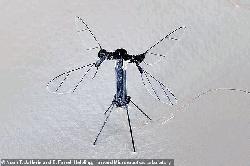A lightweight insect robot is capable of flying without being tethered to a power source, by using energy from light. The solar-powered RoboBee X-WingIt and has four wings which flap at a rate of 170 times per second, instead of a propeller to take off
A lightweight insect robot is capable of flying without being tethered to a power source, by using energy from light. The solar-powered RoboBee X-WingIt and has four wings which flap at a rate of 170 times per second, instead of a propeller to take off.
A lightweight insect robot has been created which is capable of flying without being tethered to a power source, by using energy from light.
Incredible footage reveals the solar-powered RoboBee X-Wing which uses four wings which flap at a rate of 170 times per second to fly, instead of a propeller.
Developed by a team from Harvard University, the robot has a wingspan of 1.4 inches (3.5 centimetres) and could be used to monitor the environment.
Weighing only 259 milligrams, the insect is light enough to land on leaves and tiny enough to manoeuvre through small spaces.
Wings are far superior to propellers, but scientists have struggled to replicate the natural control that insects and birds possess.
Noah Jafferis and his colleagues suggest that if they can make wings work, the flying robots will be more agile and quieter than any other man-made machine.
RoboBee uses solar panels situated over its wings to collect its own power, removing the need for an external power source.
The six tiny solar cells weigh only 10 milligrams each and are located above the wings so as not to interfere with flight.
However, the panels require an intense amount of light to power up, three times the strength of sunlight, which means outdoor flight is impossible at the moment.
RoboBee normally flies for around half a second before it flies out of the light.
Insect-based robots micro-engineered to mimic winged flight are not a new idea.
There have been previous iterations of insect robots, including older versions of the RoboBee, but they have all required been connected by a lead to a power source.
‘This is a result several decades in the making,’ said Professor Robert Wood, from Engineering and Applied Sciences at SEAS and principle investigator of the RoboBee project, in the study.
‘Powering flight is something of a Catch-22 as the trade-off between mass and power becomes extremely problematic at small scales where flight is inherently inefficient.
esn’t help that even the smallest commercially available batteries weigh much more than the robot.
‘We have developed strategies to address this challenge by increasing vehicle efficiency, creating extremely lightweight power circuits, and integrating high efficiency solar cells.’
The team hopes the robot will be able to fly in regular sunlight, and have sensing mechanisms built in.
‘It can then really control what it’s doing when it’s flying around,’ said Noah Jafferis, who led the study.
‘It’s very light for its size, he says. ‘If you needed to land on a leaf, you could, whereas a commercial quadcopter would be too heavy to do that, reports Daily Mail.




